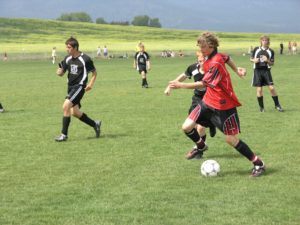POSITIVE DEVELOPMENT THROUGH SPORT
As the perceived “rewards” (playing time, starting status, varsity letters, college scholarships) of elite sport participation increase, many youth sport parents and coaches are advising children to specialize in a single sport at a young age. In doing so, these adults are making a false assumption that starting early and directing a high level of resources toward elite participation in one sport is the only pathway to success. Like most things, sport participation is a developmental process.Consequently, parents’ goals should reflect children’s stage of participation, age, and goals for participation. The stages that will be discussed in more detail in this section are:
-
Sampling
-
Specialization
-
Investment
Importantly, these stages are age-related, not age-dependent. In fact, a child’s stage is influenced more by the quality and quantity of training and competition than their age and the number of sports in which he or she participates.
Sampling
When children are in the sampling stage, they usually participate in multiple sport settings, while allocating additional time to unstructured physical activities (play!). Research on children between the ages of 6 and 13 has shown a number of psychological, social, and physical benefits of sport sampling. In building your children’s annual sport calendars, this pattern of participation allows for multiple breaks between seasons, more diverse interactions with teammates and coaches, and a greater range of skill development opportunities.
- Sampling (Age 6-13)
- Introduce children to multiple sports and allow a healthy range of free play opportunities
- Incorporate breaks in between different sports
- Maximize your children’s enjoyment of sport and provide opportunities for skill building
- Be supportive and encouraging in all instances
- Provide the necessary tangible resources: equipment, uniforms, playing opportunities, transportation
- Provide emotional and informational support before and after practices and competitions
Whether children ultimately seek to participate at an elite or recreational level, it is a parent’s responsibility to maintain a developmentally appropriate focus during the sampling years.
Specialization
When children transition to the specialization stage, they begin to narrow their focus to one or two sports they enjoy most and in which they show aptitude. A natural consequence of this transition is that young people ages 13-15 often seek to participate in fewer sports but at a more elite level. Although specialization looks different for all athletes and all families, many parents believe having young children participate in a single sport on a year-round basis is the best (and fastest) way to become an elite athlete.
Despite this belief, research indicates that year-round, single-sport participation prior to the age of 13 is associated with a number of psychological, social, and physical risks, including emotional withdrawal, burnout, and overuse injuries. In fact, most professional and Olympic athletes report having been multiple sport athletes as youth. There is a time and place for specialization, but it should be a child- not parent-driven transition!
Investment
As adolescents develop, some enter the investment stage of sport participation. A byproduct of this transition is that children aged 15 and over often narrow their participation to a single sport that becomes their primary focus of elite skill development.

- Investment (Age 15+)
- One sport, elite skill development

